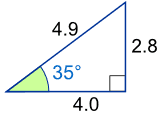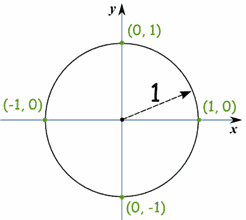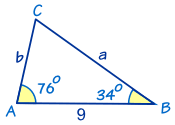Trigonometry ... is all about triangles.
Normally we using right-angled triangle to represent the triangles.
- Adjacent: adjacent (next to) the angle θ
- Opposite: opposite the angle θ
- and the longest side is the Hypotenuse
Why is this triangle so important?
Imagine we can measure along and up but want to know the direct distance and angle:


And trigonometry gives the answers!
Sine, Cosine and Tangent
They are simply one side of a right-angled triangle divided by another.
For any angle "θ":

(Sine, Cosine and Tangent are often abbreviated to sin, cos and tan.)
Calculators have sin, cos and tan, let's see how to use them:
Try Sin, Cos and Tan
Play with this for a while (move the mouse around) and get familiar with values of sine, cosine and tangent for different angles, such as 0°, 30°, 45°, 60° and 90°.
Unit Circle
- What you just played with is the unit circle.
- It is a circle with a radius of 1 with its center at 0.
- Because the radius is 1, we can directly measure sine, cosine and tangent.
Here we see the sine function being made by the unit circle:
And now you know why trigonometry is also about circles!
(Note: you can see the nice graphs made by sine, cosine and tangent.)
Degrees and Radians
Angles can be in Degrees or Radians. Here are some examples:
| Angle | Degrees | Radians |
|---|---|---|
| 90° | π/2 | |
| __ Straight Angle | 180° | π |
| 360° | 2π |
Repeating Pattern
The angle is rotating around and around the circle the Sine, Cosine and Tangent functions repeat once every full rotation.
When we want to calculate the function for an angle larger than a full rotation of 360° (2π radians) we subtract as many full rotations as needed to bring it back below 360° (2π radians):
And when the angle is less than zero, just add full rotations.
Solving Triangles
A big part of Trigonometry is solving problem. "Solving" means finding missing sides and angles.
We can also find missing side lengths. The general rule is:
When we know any 3 of the sides or angles we can find the other 3
(except for the three angles case)
Other Functions (Cotangent, Secant, Cosecant)
Similar to Sine, Cosine and Tangent, there are three other trigonometric functions which are made by dividing one side by another:

Cosecant Function:
| csc(θ) = Hypotenuse / Opposite |
Secant Function:
| sec(θ) = Hypotenuse / Adjacent |
Cotangent Function:
| cot(θ) = Adjacent / Opposite |
Trigonometric and Triangle Identities
And as you get better at Trigonometry you can learn:
- The trigonometric identities are equations that are true for all right-angled triangles.
- The triangle identities are equations that are true for all triangles (note: they don't have a right angle).







Well explained easy to understand
ReplyDeleteVery helpful!
ReplyDelete